Papers by Srimaruthi Jonnalagadda
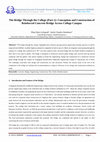
The bridge through the college" highlights how contracts and agreements signed many decades ago h... more The bridge through the college" highlights how contracts and agreements signed many decades ago have to still be respected and fulfilled. A public highway planned to originally be laid on top of a filled-out irrigation canal passing through the campus of a college that commenced in 1977 was later replaced with a elevated bridge that has finally finished completion in 2023 and is now open to public. The bridge is designed as reinforced concrete girder bridge with concrete slab top poured composite with the girders. This article explains in detail the engineering, design and construction of a reinforced concrete girder bridge through the campus of Velagapudi Ramakrishna Siddhartha Engineering College in Vijayawada city of India. The challenges associated with design and construction are also discussed. Finally, the lessons learnt at the end of the completion of the bridge are enlisted and recommendations to improve efficiency of our design and construction methods are made.
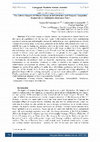
European Modern Studies Journal, 2023
With global change in climate patterns, the uncertainty of natural hazards has also gone up signi... more With global change in climate patterns, the uncertainty of natural hazards has also gone up significantly in the last few years. Cold countries have been experiencing seasons of extreme heat and drought whereas dry and arid areas have reported seasons of cold weather or torrential rains. In the past, monsoons in the Indian subcontinent have been very reliable in terms of timing and intensity; however in recent times, both their timing and intensity have been uncertain. Elsewhere in the world, tragic incidents have been reported due to freezing, heat waves or flooding most of which have been attributed to climate change caused by human living and industrialization on our planet. In this paper, the authors introduce to the perils of climate changes caused by rampant urbanization, industrialization, and the associated development. The authors present the importance of adapting every phase of infrastructure development such as materials, engineering, design, construction, and maintenance of our residential structures in order to minimize the impacts of human infrastructure development on climate. The various adaptations required to bring these changes are proposed and methods to make these adaptations practical are put forward. This first part of the overall study focuses on geometric, material and design adaptations. A plausible framework for creating sustainable urban residential infrastructure is proposed. Finally, conclusions are made, and a brief introduction is provided about the next part of this study and further adaptations that complement this framework.

International Journal for Research in Applied Science and Engineering Technology
In civil engineering practice, 1D modeling (also called line modeling) is often the most common m... more In civil engineering practice, 1D modeling (also called line modeling) is often the most common method of modeling used for the analyses of structures. It is easy to create the model and saves time without loss of significant accuracy in the results. However, these line models are ideally not a true representation of the behavior of the structure as they are overly simplified versions. Though this simplification leads to quick modeling and reduces analyses-design cycle time, this oversimplification can lead to inaccuracies and over-design that can impact the economy of construction in repeat projects. Also, in the current era of precast modular construction, it would be prudent to analyze a structure as precisely as it can be so that optimal solution is achieved before designing as standard member that can be reused across an array of projects. In this study an effort is made to model a box bridge structure to analyze and compare the behavior of the bridge under railway vehicular train loading. A Road under Bridge (RUB) of 25m barrel length is considered and analysis is carried out by creating two models subjected to IRS vehicular rail axle loading using STAAD.PRO commercial software. A comparison of flexural forces in the culvert structure is made between results of 1D line model versus 3D box finite element model. It was found that flexure at the critical sections of the box based on line model analysis are much higher than those from 3D finite element analysis. In this particular example, a 14% excess of flexural reinforcement and a 40% excess shear reinforcement are required if we design the structure based on line model of analysis. Thus it is inferred that a design based on line model analysis can be overly conservative and uneconomical. It is suggested that detailed 3D finite element analysis be performed for the design of modular and reusable members especially for precast construction and engineering.
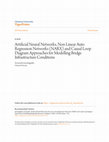
My sincere thanks to my advisor and chair Dr.Brandon Ross for his detailed advice and guidance at... more My sincere thanks to my advisor and chair Dr.Brandon Ross for his detailed advice and guidance at every stage of this research study. His enthusiastic support and professionalism were vital in conducting this demanding research. His friendly and helpful nature during my tough times will always be remembered. My special thanks to Dr. Amin Khademi for his valuable guidance in applying Artificial Intelligence methods. He was very approachable and always willing to help me while I was learning this new domain. Thanks to Dr.Weichiang Pang and Dr.Mashrur Chowdhury for providing their valuable inputs in making my research more purposeful. This is the time to recollect the role of my elder brother Mr. Lakshmi Ganapathi in shaping my persona. Starting from my middle school days through all of my academic and professional life, his inspiring letters ignited my passion to dream big, work hard and achieve those dreams. He is a great inspirer and true leader. I attribute my success to his selfless guidance. May God shower blessings on him and his family at all times. I am very grateful to Dr.B.S.R.K Prasad, Professor and Head of Civil Engineering, GITAM School of Technology, Hyderabad for instilling in me an early fascination for structural engineering with his amazing teaching clarity. The support of my mother Savitri and the love of my wife Sirisha and my kids Sankar, Nandini were fundamental in persevering through this long journey. I am blessed to have a wonderful family. I miss my father late Venkateswara Rao during this moment. My love for structures could not have been so strong if not for the countless debates I had about them with my friend Phani Ram. He is a great source of inspiration. vii

The quality of bridge infrastructure is affected by a variety of factors. Traffic and aging deter... more The quality of bridge infrastructure is affected by a variety of factors. Traffic and aging deteriorate bridges; maintenance and repair operations mitigate deterioration. The overall quality of a bridge inventory is also affected by new construction, and through removal or improvement of poor bridges. This study uses tools from the field of systems dynamics to study changes to the quality of bridge inventories. A causal loop diagram (CLD) is developed to qualitatively describe the relationships and actions impacting the quality and improvement costs of a bridge inventory. Relationships expressed in the CLD consider physical, economic, and policy factors. A quantitative model is also developed, which is based on a portion of the CLD. Using South Carolina as a test subject, the model is used to calculate the inventory-level improvement costs as a function of annual improvement budget. Data from the National Bridge Inventory are used to develop the model. This paper is presented as a first step towards the use of system-based approaches to study highway bridge inventories. Recommendations are given for extending the proposed CLD and quantitative model.

As of 2013, 14% of highway bridges were classified as functionally obsolete. This classification ... more As of 2013, 14% of highway bridges were classified as functionally obsolete. This classification is given to bridges that have capacity and geometric conditions that do not satisfy modern requirements and thereby limit usage. The first part of this paper is a general discussion of obsolescence and sustainability of highway bridges, and describes the impact of obsolete bridges on economic, social, and environmental sustainability. The second part of the paper proposes a theoretical model for quantifying obsolescence due to load carrying capacity, a subcategory of functional obsolescence. The model includes features to account for increasing load demand and decreasing structural capacity over time. Historic trends for bridge design loads are discussed as they relate to the model, as are methods for calculating degradation of structural capacity. Limitations, applications, and possible extensions of the model are discussed. The third part of the paper applies the capacity obsolescence ...

Journal of Structural Integrity and Maintenance
While routine inspections are commonly used to assess the structural integrity, safety, and maint... more While routine inspections are commonly used to assess the structural integrity, safety, and maintenance needs of individual highway bridges, data from these inspections can also be used to study performance of bridges at the inventory level. This paper presents a novel method by which inspection data can be used to evaluate design variables and inform future designs. In particular, inspection data from prestressed concrete bridges in Southeastern United States were used to develop artificial neural networks models for estimating the condition rating of bridge decks and superstructures as a function of skew angle and span length, as well as, bridge age, width, and traffic level. Once developed and validated, the neural network models were used for an array of simulations that were designed using a full factorial approach. The objective of the simulations was to identify skew angles and span lengths that correlate with the highest inspection ratings. It was determined that deck ratings are highest for smaller skew angles and shorter span lengths, whereas superstructure ratings are minimally impacted by larger skews and unrelated to span length. The conclusions of this study will be helpful in understanding the implications of bridge design variables on the long term performance of bridge decks and superstructures. Though the trends and conclusions noted in this study are to be seen within the scope of the data considered, the approach demonstrated in this paper can be applied to address other questions of bridge performance.
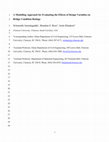
Journal of Structural Integrity and Maintenance- Taylor& Francis, 2016
While routine inspections are commonly used to assess the structural integrity, safety, and maint... more While routine inspections are commonly used to assess the structural integrity, safety, and maintenance needs of individual highway bridges, data from these inspections can also be used to study performance of bridges at the inventory level. This paper presents a novel method by which inspection data can be used to evaluate design variables and inform future designs. In particular, inspection data from prestressed concrete bridges in Southeastern United States were used to develop artificial neural networks models for estimating the condition rating of bridge decks and superstructures as a function of skew angle and span length, as well as, bridge age, width, and traffic level. Once developed and validated, the neural network models were used for an array of simulations that were designed using a full factorial approach. The objective of the simulations was to identify skew angles and span lengths that correlate with the highest inspection ratings. It was determined that deck ratings are highest for smaller skew angles and shorter span lengths, whereas superstructure ratings are minimally impacted by larger skews and unrelated to span length. The conclusions of this study will be helpful in understanding the implications of bridge design variables on the long term performance of bridge decks and superstructures. Though the trends and conclusions noted in this study are to be seen within the scope of the data considered, the approach demonstrated in this paper can be applied to address other questions of bridge performance.

Transportation Research Board 96th Annual meeting (TRB) Compendium of papers, 2017
The quality of bridge infrastructure is affected by a variety of factors. Traffic and aging deter... more The quality of bridge infrastructure is affected by a variety of factors. Traffic and aging deteriorate bridges; maintenance and repair operations mitigate deterioration. The overall quality of a bridge inventory is also affected by new construction, and through removal or improvement of poor bridges. This study uses tools from the field of systems dynamics to study changes to the quality of bridge inventories. A causal loop diagram (CLD) is developed to qualitatively describe the relationships and actions impacting the quality and improvement costs of a bridge inventory. Relationships expressed in the CLD consider physical, economic, and policy factors. A quantitative model is also developed, which is based on a portion of the CLD. Using South Carolina as a test subject, the model is used to calculate the inventory-level improvement costs as a function of annual improvement budget. Data from the National Bridge Inventory are used to develop the model. This paper is presented as a first step towards the use of system-based approaches to study highway bridge inventories. Recommendations are given for extending the proposed CLD and quantitative model.
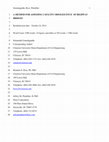
Transportation Research Board 94th Annual Meeting (TRB) Compendium of Papers, 2015
As of 2013, 14% of highway bridges were classified as functionally obsolete. This classification... more As of 2013, 14% of highway bridges were classified as functionally obsolete. This classification is given to bridges that have capacity and geometric conditions that do not satisfy modern requirements and thereby limit usage. The first part of this paper is a general discussion of obsolescence and sustainability of highway bridges, and describes the impact of obsolete bridges on economic, social, and environmental sustainability. The second part of the paper proposes a theoretical model for quantifying obsolescence due to load carrying capacity, a subcategory of functional obsolescence. The model includes features to account for increasing load demand and decreasing structural capacity over time. Historic trends for bridge design loads are discussed as they relate to the model, as are methods for calculating degradation of structural capacity. Limitations, applications, and possible extensions of the model are discussed. The third part of the paper applies the capacity obsolescence model to an example problem involving a simple span reinforced concrete bridge. The example demonstrates a methodology for simultaneously evaluating capacity obsolescence and environmental impact using multi-criteria decision analysis (MCDA). The paper concludes by suggesting future research to advance the proposed methodology. The overall objectives of the paper are to propose a model for quantifying obsolescence and to demonstrate how obsolescence can be jointly considered with other bridge design criteria.











Uploads
Papers by Srimaruthi Jonnalagadda